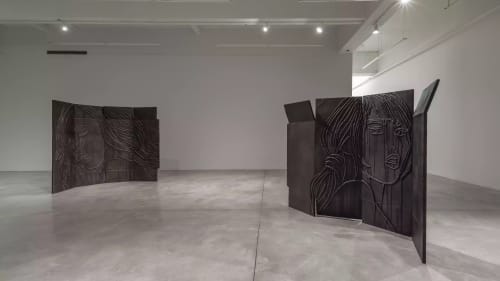Ghada Amer never intended to make folding screens for “Paravent Girls,” her show on view at New York’s Tina Kim Gallery through December 9th. Even so, there they are—cast in bronze from flattened cardboard boxes, and in the show’s title, which borrows the French word for these sculptural room dividers.
Amer’s ambivalence came from the function of screens, which “always hide something,” as the artist said in an interview with Artsy. “I’m more interested in the dividing aspect than the hiding aspect,” she explained. Blown up on one side of Amer’s zigzagging bronze sculptures are bold sketches of appealing young women. Many are appropriated, as is common in her practice, from porn magazines: These “girls” are certainly not concealing themselves.
Amer’s works tap into current global interest in folding screens as an art form. Her show in New York coincides with a new exhibition, “Paraventi: Folding Screens from the 17th to 21st Centuries,” which unfolds across Fondazione Prada’s Milan, Shanghai, and Tokyo spaces. The institutional show considers the history of the format, from its use in Zhou dynasty China for objects of contemplation, all the way through contemporary artists’ appropriation of the medium as a barrier-cum-canvas. Folding screens continue to pop up, splitting art fair booths, gallery spaces, and museum halls, as artists use these divisive devices to examine current ideas on representation, as well as our collective infatuation with digital and projection screens.
—Josie Thaddeus-Johns


